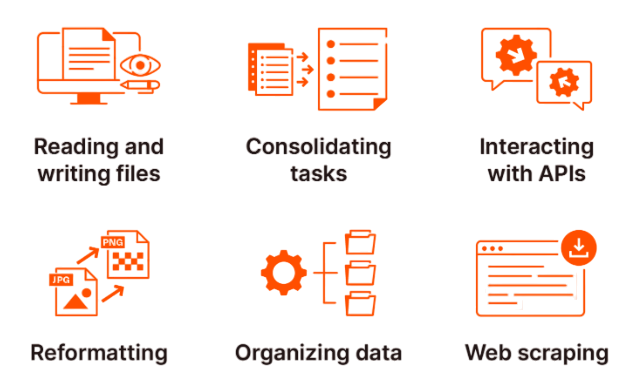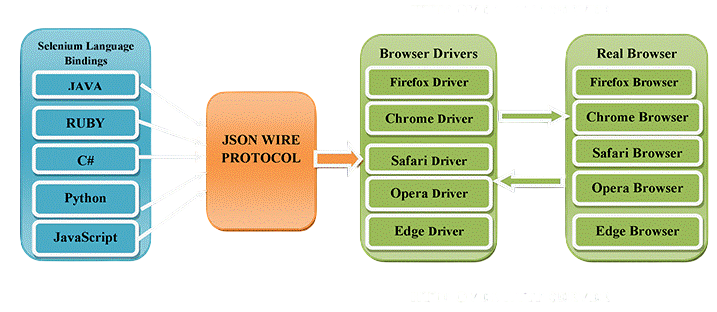
- Introduction to Automation with Python
- Why Automate Coding Tasks?
- Python Basics for Automation
- Common Automation Libraries (os, time, shutil, re, etc.)
- Automating File and Folder Management
- Web Automation with Selenium and Requests
- Email and Messaging Automation
- Automating Excel and CSV File Tasks
- Conclusion
Introduction to Automation with Python
Automation refers to the use of technology to perform tasks with minimal human intervention. Python, with its simplicity and versatility, has become one of the most popular programming languages for automation. It allows users to automate repetitive tasks such as file handling, web scraping, data entry, report generation, and email processing. One of Python’s strengths is its rich ecosystem of libraries and frameworks. Tools like Selenium can automate web browsers Python Training, Pandas and OpenPyXL are ideal for manipulating Excel files, and BeautifulSoup or Scrapy can be used for web scraping. These libraries simplify complex tasks, enabling users to build automation scripts with minimal code. Python’s readable syntax makes it accessible for both beginners and experienced developers. Its cross-platform compatibility ensures scripts can run on different operating systems with little modification. Automation with Python improves efficiency, reduces human error, and saves time, making it valuable in both professional and personal workflows. Whether you’re managing data, testing software, or handling administrative tasks, learning Python automation equips you with powerful tools to optimize your work. In summary, Python is an excellent choice for automation due to its ease of use, flexibility, and strong community support, making it a key skill in today’s digital landscape.
Do You Want to Learn More About Python? Get Info From Our Python Online Training Today!
Why Automate Coding Tasks?
Manual repetition of tasks can be both time-consuming and error-prone. Automating such tasks improves efficiency, ensures consistency, and reduces human error. From renaming hundreds of files to testing APIs or scraping web content, automation removes the tedium and allows professionals to focus on higher-level problem-solving.

Automating coding tasks increases efficiency, reduces human error, and saves valuable time. Repetitive tasks like code formatting, testing, deployment, and documentation can be automated to ensure consistency and reliability. This allows developers to focus on more complex, creative aspects of programming. Automation also improves collaboration by enforcing coding standards and streamlining workflows Python Developer Skills through tools like linters, CI/CD pipelines, and version control integrations. Additionally, it enhances productivity, shortens development cycles, and helps maintain code quality across projects. Overall, automation is a key practice in modern software development, enabling faster, cleaner, and more scalable coding processes. In both personal and professional projects, Python helps automate almost everything from coding routines to file management, data processing, and testing.
Python Basics for Automation
Before diving into advanced automation libraries, it’s crucial to understand some core Python concepts:
- Variables and Data Types
- Loops and Conditionals
- Functions and Modules
- File I/O operations
- Exception Handling
These fundamentals allow you to script tasks such as checking file existence, reading and writing files, and parsing logs. Understanding Python’s syntax for these Building a Career as a Python Developer basic constructs is the foundation upon which automation scripts are built.
Common Automation Libraries (os, time, shutil, re, etc.)
Python’s standard library provides a solid set of modules to automate a wide variety of tasks:
- os: For file/directory handling and operating system interaction.
- shutil: For copying and moving files.
- time: For delaying actions and measuring execution time Python Training.
- re: For performing pattern matching and text extraction using regular expressions.
- subprocess: For running shell commands.
- sys: For accessing command-line arguments and system info.
- json/csv: For parsing data formats.
- import os, shutil
- for filename in os.listdir(‘Downloads’):
- if filename.endswith(‘.pdf’):
- shutil.move(f’Downloads/{filename}’, f’Documents/PDFs/{filename}’)
- Batch rename files to maintain consistency in naming conventions.
- Automate backups by copying files to a backup location on a schedule.
- Search for specific files or extensions across directories Best Python IDEs and Code Editors .
- Clean up unused or temporary files to free up storage.
- Schedule tasks (e.g., daily cleanup) using tools like schedule or cron.
- Set permissions or check file access rights programmatically.
- Generate reports of file structures, sizes, or changes over time.
- Compress or extract files and folders using modules like zipfile or tarfile.
- requests: For accessing APIs, downloading web pages.
- beautifulsoup4: For parsing HTML and web scraping.
- selenium: For browser automation like filling forms, clicking buttons, scraping dynamic content Python Serialization .
- import requests
- response = requests.get(‘https://jsonplaceholder.typicode.com/posts’)
- data = response.json()
- print(data[0][‘title’])
- from selenium import webdriver
- driver = webdriver.Chrome()
- driver.get(“https://www.google.com”)
- search_box = driver.find_element(“name”, “q”)
- search_box.send_keys(“Python automation”)
- search_box.submit()
Example:
This script moves all PDFs from the Downloads folder to a specified location, saving hours of manual sorting.
Want to Pursue a Python Master’s Degree? Enroll For Python Master Program Training Course Today!
Automating File and Folder Management
Create, rename, move, or delete files and folders using libraries like os and shutil. Organize files automatically by type, date, or size (e.g., sorting documents, images, etc.).
Python’s built-in modules make file and folder automation efficient and customizable, ideal for both personal and enterprise use.
Web Automation with Selenium and Requests
Python is widely used for automating web interactions:

Example using requests:
Example using selenium:
Web automation can be applied in testing, form submissions, scraping, and bot development.
Email and Messaging Automation
Email and messaging automation allows users to streamline communication tasks, saving time and improving efficiency. With Python, automated emails can be sent using the smtplib and email libraries, while incoming messages can be read and processed through tools like imaplib or APIs such as Gmail API and Microsoft Graph. Scheduling emails for future delivery is made easy with modules like schedule or APScheduler. Python also enables the automatic sending of attachments such as reports, PDFs, or images. For messaging platforms like Slack What is pip , WhatsApp, or Telegram, Python wrappers such as slack_sdk, py whatkit, and python-telegram-bot allow users to send messages, alerts, or reminders programmatically. Automated systems can also generate dynamic message content based on templates or data inputs from Excel or databases. Additionally, Python can be used to set up auto-responses or trigger messages based on specific events, such as errors, updates, or scheduled reports. Modern security practices like OAuth2 ensure safe authentication when dealing with email and messaging services. Overall, automating communication workflows with Python enhances productivity, ensures timely updates, and reduces the manual effort required for routine messaging tasks.
Preparing for a Python Job? Have a Look at Our Blog on Python Interview Questions and Answers To Ace Your Interview!
Automating Excel and CSV File Tasks
Automating Excel and CSV file tasks with Python significantly improves data handling efficiency, especially for repetitive or large-scale operations. Python libraries like Pandas, OpenPyXL, and CSV make it easy to read, write, and manipulate spreadsheet data with just a few lines of code. For CSV files, the built-in csv module and Pandas can be used to automate tasks such as reading rows, filtering data, merging files, Average Annual Salary of a Python and exporting results. With Excel files, libraries like openpyxl and xlsxwriter allow users to create and update spreadsheets, apply formatting, insert formulas, and generate reports dynamically. Python scripts can automate the cleaning and transformation of raw data such as removing duplicates, correcting formats, or converting columns making it ideal for data preprocessing. It can also be used to schedule automated reports, track changes over time, or update dashboards. In business and research settings, this level of automation reduces manual errors, speeds up workflows, and ensures consistent results. Whether you’re working with financial data, sales records, or survey responses, Python enables seamless and scalable automation of Excel and CSV tasks, allowing users to focus on insights rather than data entry or formatting.
Conclusion
Python empowers developers to automate almost any digital task making coding smarter, Common Automation Libraries not harder. From mundane chores like renaming files to high-impact tasks like automating test pipelines, the applications are limitless. Mastering Python for automation is a career-boosting skill that enhances productivity, improves software reliability, and saves invaluable time. Whether you’re just starting or aiming to become a DevOps engineer or data analyst, embracing automation with Python Training can set you apart in the tech world. Automation with Python is a powerful way to simplify and accelerate many everyday tasks, from managing files and folders to handling emails and working with data in Excel or CSV formats. By leveraging Python’s extensive libraries and easy-to-learn syntax, both beginners and professionals can save time, reduce errors, and improve productivity. Whether it’s automating repetitive coding tasks, streamlining communication, or organizing data, Python offers versatile solutions that fit a wide range of needs. Embracing automation not only enhances efficiency but also allows you to focus on more creative and strategic aspects of your work, making it an essential skill in today’s digital world.


